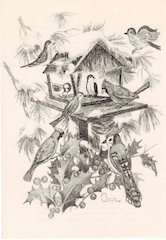Ann Adams

Ann Adams (1937-1992) was an American artist who, after becoming almost fully paralyzed due to Poliomyelitis, re-learned to draw by using a pencil held in her mouth.[1][2][3]
Early life
Adams was born in Jacksonville, Florida and had a sister, Margaret.[4] At age 19, Adams married a Navy officer.[4] Their only child, a son named Kenny, was born two years later.[4]
Illness
At age 21[5] or 23,[4] Adams contracted polio, although the cause was unknown.[4] She was an art major at Florida State University[5] or had started art school in Jacksonville in 1950, but the disease totally destroyed her nerves, and paralyzed all but a few facial and neck muscles.[4] She spent a year and a half in a hospital in Jacksonville and another year and a half in a rehabilitation center in North Carolina. After this, Ann spent five years, spending up to 24 hours a day, inside an iron lung due to her inability to breathe on her own.[4]
Her husband was unable to cope with Adam's disability, divorcing her three years after contracting the illness and he received primary custody of their son due to her hospitalization. Her parents cared for her during this time, and the March of Dimes (then the National Foundation for Infantile Paralysis) provided financial and medical assistance.[4] Under the care of the Central Carolina Convalescent Hospital, she laid in a rocking bed which helped her body, paralyzed from the neck down, breathe. Her mind was alert and she was given an adaptive device[6] invented by Frank Reck[7] and made by a dentist, Dr. Coble, that allowed her to type letters using her mouth. She was also fitted with an electric typewriter and given a page turner, made by Harry Doll of Western Electric Company, so that she could read a book by herself.[6][7]
The Southeastern Respiration and Rehabilitation Center in Augusta, Georgia provided Adams with a corset breathing device, where a rubber bag mimicked the negative pressure needed to breathe so that she could spend four hours a day where she was free of the iron lung; additionally, the center had a unique rocking bed and mouth hose device that allowed her to sleep normally. The meant that she could spend twelve hours a day outside the iron lung.[4] Despite this freedom, it was eight years before she was able to return to artistic pursuits.
Artistic career

After she was able to sit up in a wheelchair with a breathing device,[7] she trained herself to draw using a pencil held between her teeth[7] with a mouth grip. An adjustable easel was setup to hold her paper and a tray for paints. She finished her first drawing of a chapel in the woods ten years after getting polio.[5] Each of her works of art took about two months to complete.[7][8] She made drawings and paintings that were used in Christmas cards,[9][7] like Madonna and Child.[10] She also made drawings for other greeting cards and was nationally known for that work. Some of the drawings included landscapes, puppies, and kittens.[11] The drawings were printed and sold[5] through her mail-order business.[11]
By 1972, she supported herself with her artwork, living in her own home, and traveling with a portable iron lung. She required constant care and was still spending her nights in an iron lung.[5] She was still working in 1990.[12] She encouraged other people with disabilities and enjoyed reading, listening to music, and cooking.[11]
References
- ↑ Hecht, Alan (2017-03-22). Polio. Infobase Publishing. ISBN 9781604132380.
- ↑ New York Media, LLC (June 9, 1975). New York Magazine. New York Media, LLC. p. 60. ISSN 0028-7369.
- ↑ R. C. Bradley (1975). Jesus, the Greatest Master Teacher of Us All. University Press. p. 67. ISBN 978-0-8418-4480-3.
- 1 2 3 4 5 6 7 8 9 Paulos, Dan. "Lift Up Your Heart: Ann Adams and the Art of Living". Catholic Digest. Archived from the original on 6 February 2012. Retrieved 21 March 2017.
- 1 2 3 4 5 Sandra Earley Marsh (January 8, 1972). "Make My Story Joyful 'I Am Not a Tragedy'". Florida Today. Cocoa, Florida. p. 1D. Retrieved March 25, 2017 – via newspapers.com.
- 1 2 "Polio Patient Types with Mouth". The Robesonian. Lumberton, North Carolina. July 17, 1953. p. 2. Retrieved March 25, 2017 – via newspapers.com.
- 1 2 3 4 5 6 "Polio Girl Paints Christmas Cards". News-Press. Fort Myers, Florida. December 29, 1967. p. 12. Retrieved March 25, 2017 – via newspapers.com.
- ↑ United States Naval Oceanographic Office (1970). Bulletin. The Office. p. 3.
- ↑ Journal of Rehabilitation. 28. National Rehabilitation Association. 1962. p. 55.
- ↑ Clifton J. Allen (April 1, 1980). Life is Worth your Best. Broadman Press. p. 152. ISBN 978-0-8054-5276-1.
- 1 2 3 Helene de Groodt (April 9, 1981). "Handicap no obstacle to artist's creativity". The Orlando Sentinel. p. 1C, 4C. Retrieved March 25, 2017 – via newspapers.com.
- ↑ "Pretty as a picture". Florida Today. November 19, 1990. p. 10. Retrieved March 25, 2017 – via newspapers.com.